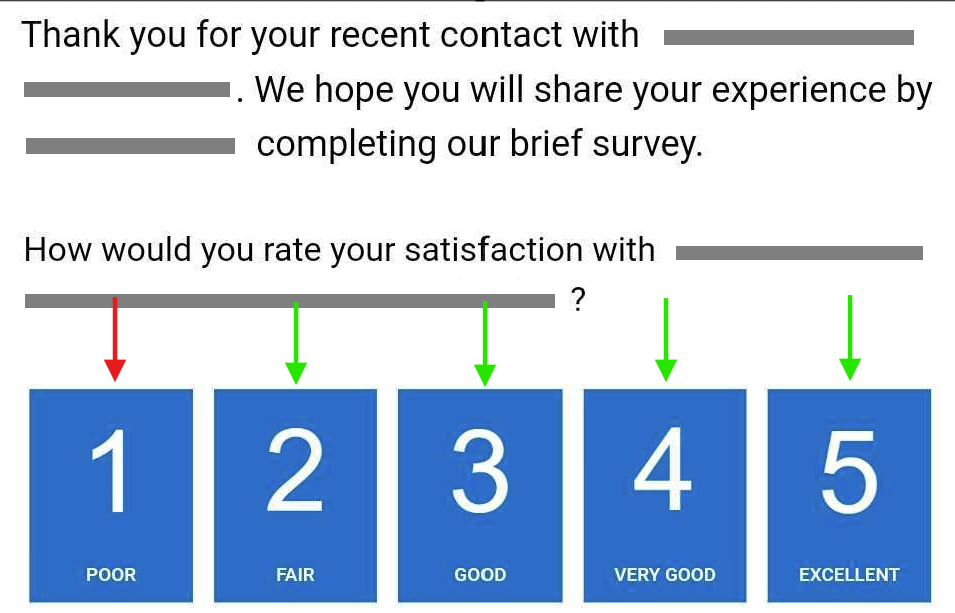The Innocent-Looking Survey
Back in March, I received a survey from a well-known financial services company. I hid some bits from the picture but you know the type—they pop up in your inbox, looking all innocent, asking you to “share your experience” after a recent interaction. Naturally, I opened it up, curious to see what they were asking. And what did I find? A little dose of Dark CX practice for breakfast.
Survey Design: Biased by Default
When a company sends you a survey, it’s supposed to be a genuine attempt to gather feedback, right? They want to hear your thoughts, and maybe even implement some fancy continuous improvement programme based on your insights. That’s what they tell us, anyway.
But take a closer look at this survey. You’re asked to rate your satisfaction on a scale of 1 to 5. Seems fair, until you realise that the middle option, 3 out of 5, is labelled “good.” Wait a minute—since when did “good” become the middle ground? And as if that wasn’t enough, your other options include “very good” and “excellent.” On the flip side, you’ve got “fair” (which feels neutral, but isn’t) and finally “poor,” the only truly negative option.

So, in essence, you’re given three positive choices, one neutral, and one negative. Where’s the balance in that? Spoiler alert: there isn’t any. This survey is less about collecting genuine feedback and more about skewing results in their favour. It’s like being asked if your day was “amazing, fantastic, or brilliant.” No room for a bad day here!
Taking the Bias to the Next Level
If you’re already skewing results, why not take it a step further? Why bother with multiple options at all? Imagine a survey that asks: “How would you describe your experience with us?” and offers only these choices: Great, Fantastic, Brilliant, Excellent, Delightful. All positive, right? But why stop there? Let’s cut to the chase and offer just one option: “Exceptional.” Or better yet, let’s go all out with “Freaking Awesome!”
If you ever see a company boasting about how their customers rate them as “freaking awesome,” remember this post and ask yourself: were those customers even given any other choice?
What’s Really Going On Here?
This approach to survey design is questionable in some aspects, and it raises some serious concerns about the intent behind it. It seems as though the company might be more focused on hitting targets, possibly tied to performance bonuses, rather than genuinely understanding customer satisfaction. And let’s be honest, what better way to meet those targets than by gently nudging customers towards the more positive responses?
But here’s the kicker: some methodologies from the Dark CX side actually encourage eliminating neutral options, arguing that these don’t offer actionable insights. This is not untrue, but at the same time, there are a million reasons why a respondent might not feel comfortable fitting into any of the options provided. It’s always good practice to offer a neutral or “not applicable” choice.
Some proponents of this approach argue that they want to “force” customers to pick the most relevant option, even if it’s not a perfect fit. Excuse me—”force” customers? If that’s your strategy, good luck! Forcing customers rarely ends well. Customers who feel pressured are more likely to abandon the survey altogether, leaving you with a poor completion rate and even less actionable insight than you started with.
Next Time, Think Twice
The most effective antidote to Dark CX practices is using the power that customers have to ignore surveys that, like this one, seem to be dragging us in a specific direction, and are not really interested in us using our valuable time to give our honest opinion hoping for improvements. So, the next time you’re asked to fill out one of these surveys, take a moment to consider what’s really being asked. Is the company genuinely interested in your feedback, or are they just fishing for compliments? Your opinion matters, but only if it’s truly heard.
For those in charge of customer experience, here’s a tip: if you truly care about improving, start by asking real questions and be prepared for real answers. Don’t shy away from neutrality or negativity—embrace them as opportunities to learn and grow. After all, the best insights often come from the toughest feedback.
Authentic feedback isn’t just a checkbox. It’s the foundation of meaningful customer relationships and lasting improvement.

